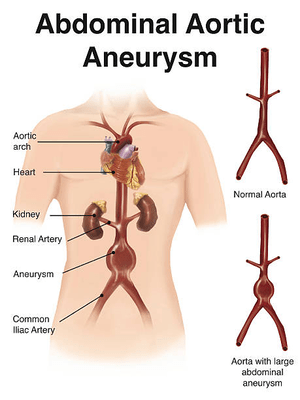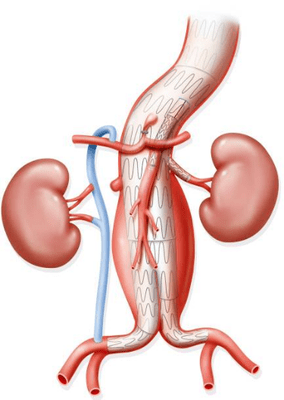 Know the Facts
Know the Facts
The aorta is the largest artery in the body. An abdominal aortic aneurysm (AAA) occurs when the wall of the aorta weakens and begins to bulge. An AAA may continue to grow larger without causing any symptoms. If it is not diagnosed and is left untreated, it may eventually rupture and could lead to death.
Symptoms
Most individuals with an AAA have no symptoms. When symptoms do occur, pain located in the abdomen, back or flank, is the most common clinical manifestation. The classic triad of severe acute pain, a pulsatile abdominal mass and hypotension occurs in approximately 50% of patients with a ruptured AAA.
Risk Factors
Risk factors include family history, current or past tobacco use, high blood pressure, Age 60+, high cholesterol, heart disease, previous aneurysm, connective tissue disorders, male sex and obesity.
Diagnosis
Noninvasive: Physical exam, abdominal duplex ultrasound, CT scan and Magnetic resonance angiogram (MRA)
Invasive: Arteriography
Treatment Options
 Lifestyle modifications, such as quitting smoking, eating healthy, controlling cholesterol/high blood pressure, increasing physical activity and managing diabetes can improve patient outcomes.
Lifestyle modifications, such as quitting smoking, eating healthy, controlling cholesterol/high blood pressure, increasing physical activity and managing diabetes can improve patient outcomes.
In addition to lifestyle modifications, medication may be prescribed for blood pressure, cholesterol and diabetes control. Antiplatelets (prevent platelets from sticking together, most common is aspirin) and anticoagulation (blood thinner) therapy may be prescribed, as well.
There are also minimally invasive surgical options, such as an endovascular repair or EVAR. It involves inserting a graft within the aneurysm through small groin incisions while using x-rays to guide the graft into place. The advantage of this type of repair is that there is no open abdominal surgery and less down time in the hospital. Not every patient is a good fit for an EVAR. Aneurysms arising close to or above the kidneys are more difficult to treat this way.
Open aneurysmal repair is performed through a large abdominal incision that exposes the aneurysmal aorta. After the aorta is clamped to stop blood flow, the aneurysm is then opened and cleared of any debris or blood clots. A graft is sewn into place restoring the normal size and contour of the aorta allowing blood to flow to the lower extremities. The aorta is then sewn back together around the graft and the incision site is closed.
You and your physician will determine which treatment option is best for you.

